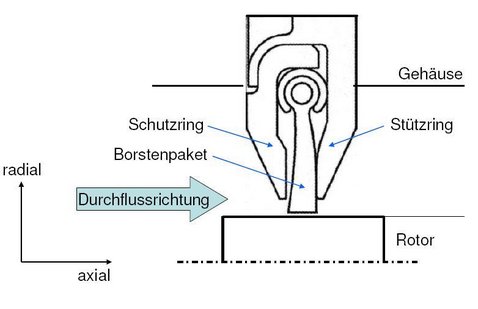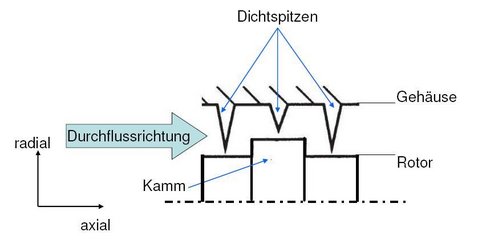Rotordynamic characteristics of brush seals
Project Objective
When optimizing the efficiency of flow machines, the reduction of leakage losses becomes an important objective. Currently, labyrinth seals are considered state-of-the-art when dealing with industrial steam turbines. They are used in the turbine primarily in places such as the thrust balance pistons, the shovel wide belts and the shafts. The technical boundaries of labyrinth sealing, however, lie in their sensitivity to the friction between the rotating parts, that always result in a certain gap width and, ultimately, leakage losses.
Brush seals offer a good alternative to these problems. They consist of a set of fine wires that are arranged in a defined positioning angle. The brush seal has a considerably better sealing effect, and takes up a minimal amount of space. The superior sealing properties of this form of sealing is adequately recognized, but a need for further research still exists regarding its effect on the rotordynamic behavior of the steam turbine. At the heart of the investigation lies the establishment of stiffness and damping coefficients of brush seals, as well as the investigation of aerodynamic forces with a destabilizing effect. The knowledge gained from the latter investigations should serve to enable the use of brush seals in power plant turbine areas without stability problems.
Methods
There are two testing facilities for the examination of turbine seals under static and dynamic working conditions at the institute for energy systems: the static test facility allows for the measurement based determination and evaluation of the pressure distribution in the sealing chambers at varying rotor eccentricities and rotational speeds. The air supply in the testing facility also allows for a variation of the air supply parameters, such as pressure drops and swirls. Through the integration of pressure distribution, it becomes possible to obtain the stiffness coefficients of the seal configuration.
The dynamic testing facility allows for the determination of the stiffness coefficient, as well as the determination of the damping coefficient. These are gained experimentally through the stimulation of the rotor system with a magnetic bearing, and the aerodynamic forces acting in the seal, up to the limit of stability. Those magnetic bearing forces working in tangent and radial direction can be determined directly out of their calibration curve. The difference between measurements with and without air supply provides the actual influence of the tested sealing system.
Parallel to the experimental determination of the rotordynamic characteristics, a theoretical model to predict the stiffness and damping coefficients is being developed. This is based on a three dimensional CFD Model of the seal being investigated. The seal’s set of bristles is treated as a porous medium in the simulation. The goal here is the creation of a CFD program for the determination of the leakage and the rotordynamic characteristics of a brush seal.
For more information
Contact the staff member responsible:
Dipl.-Ing. Manuel Gaszner
Dr. Alexander Pugachev
KW21 website: Link

